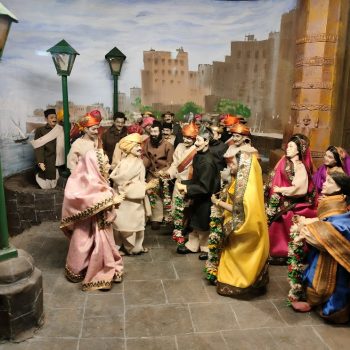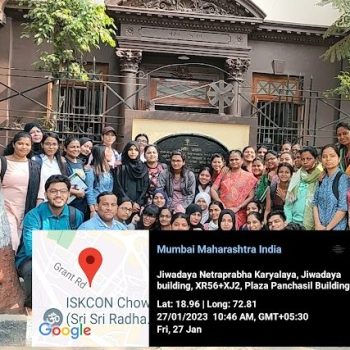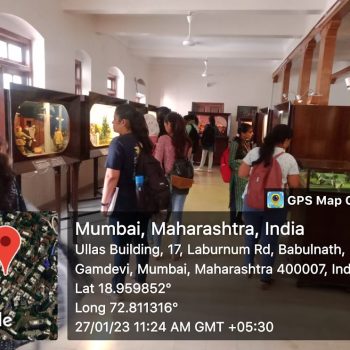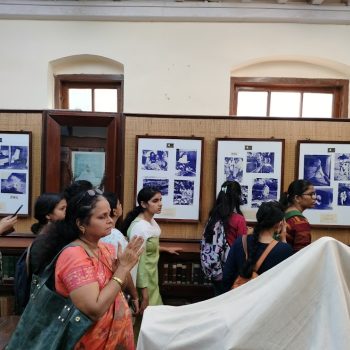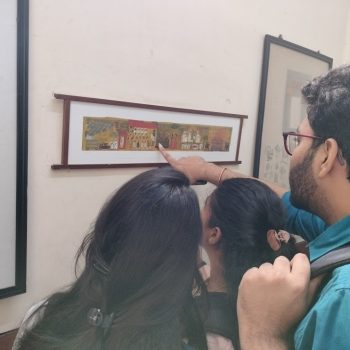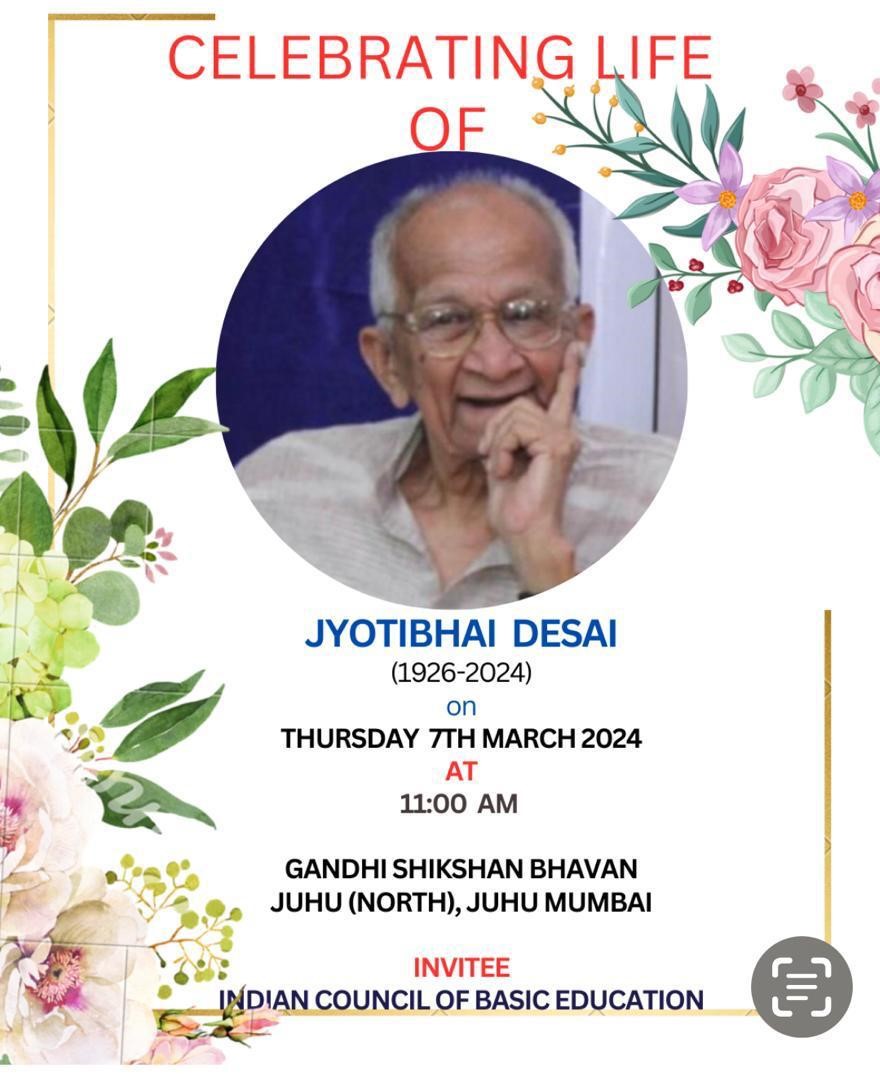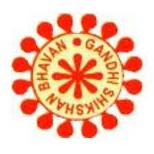
Mani Bhavan Visit | 27th Jan 2023
MANI BHAVAN AND GANDHI
NAME: Praizia Godinho ( F.Y.B.Ed , roll no 12)
On 27 January 2023 , F.Y.B.Ed students of Gandhi Sikshan Bhavan’s , Smt Surajba college of education attended a visit to Mani Bhavan ( name of Gandhiji’s museum in Mumbai ) recently . It is the place where the Mahatma ( the great soul) of the world was staying in Bombay somewhat about seventeen years from 1917 to 1934 .We all , me and my colleagues reached Grant road station at 10.00 am then we waited for some time , for them we all with our coordinator Pradnya Bosekar ( college librarian) walked together towards west for the destination . From Mani Bhavan some of the historic movements including the Satyagraha ( literally meaning love for truth , it may also imply peaceful resistance) against the Rowlatt Act ( a repressive British law ) in 1919 , non- cooperation movement 1912-1922, the civil disobedience movement 1932 were conceived.
Firstly On the ground floor there was a library in which all the books of Gandhiji written in English , Hindi .Gujarati . Many slogans written for Gandhiji were also shown, On the first floor there were pictures gallery, pictures were hanged on the walls of each floor and the corridor’s even on the walls of the stairs . Pictures depicted his photos from childhood , his meeting’ s with Jawaharlal Nehru and Sardar Vallahbhai Patel . The childhood pictures of Gandhiji included his early age , with brothers , As a law student 1888-1891, South Africa 1893 -1914 , Gandhiji Tolstoy Correspondence 1901-1910, Arrest during the Protest March to Transvaal 1913 . How Gandhiji spent 249 days in South Africa prison’s , The photo’s of Gandhiji and Kasturba Bai on Return to India 1915 . People spontaneously addressed him as Mahatma the great soul Satyagraha ashrams at Kochrab and Sabarmati 1915-1917(Jivan Charkha ) , Cycled to Reach Prayers in Time , Used to
shave without a mirror and the Scavening Gandhiji’s Epoch Making Books , When the right hand was exhausted he wrote with left hand , Gandhiji always insisted people for good handwriting , as though bapu had a bad one later he learnt a lot . There were Gandhiji’s autograph’s in different Scripts and His few earthly possessions . The Great Salt March to Dandi 1930 , He played with children and the children enjoyed playing with bapu. An Evening meal during the long conference with the new viceroy Lord Mountbatten Delhi April 1947 , by the time of their meeting. Evolution of the National Flag .The passport issued to Gandhiji for attending the Round Table Conference August 28, 1931 .In the passport his citizenship was written as ‘British protected subject’ (perhaps that was the status of all Indians then), his height five feet four inches, his occupation as ‘farmer (bar-at-law) non practicing.’ There are many such interesting things one can find in Mani Bhavan.The goal of absolute Independence Einstein’s Tribute to Gandhiji , I read the message of Albert Einstein on Gandhi , and he rightly says hardly future generations will believe that such man of flesh and blood ever walked on earth !. In the middle of the Picture gallery there was a hut made of clay where Gandhiji and Kasturba lived at Sevagram From (1936 to 1946) , Gandhiji’s Death photo’s , The Newspaper which was published on the next day of Gandhiji’s Death ( January 30 1946) , The slogan written was “Years have gone by , A Thousand more may go and yet he will live in mankind ” .
On the stairs to the second floor also there were many pictures of Gandhiji after 1914 . Next to the entrance was Gandhiji’s room , After that there was a small statue of Gandhiji in the centre with some quotes and pictures of Gandhiji round it . Next to that was a Doll museum which is the best part of mani bhavan and this visit . I was a very heart touching museum , The paintings o his birth at Kirti Mandir on
October 2,1869 , Porbandar , displaying humiliation as he was thrown out from his first class rail car in Pietermaritzburg in South Africa , his fight against the discrimination , his Tolstoy farm ( including his letter exchanges with Leo Tolstoy) , are well preserved in that museum . I was moved by that particular painting , belonging to both Hindi Muslim fanatics in Bengal , surrendering their arms before Mahatma Gandhi as he was in fast unto death to stop communal violence .His role in Indian freedom struggle , his arrest from the terrace tent of Mani Bhavan his visit to communal violence affected area’s of Bengal Bihar are well depicted . Similarly his Dandi match in 1930 to break discriminatory salt law was equally heart thrilling . Gandhi then 61 years old along with some of his followers , walked about 216 miles from Sabarmati Ashram in Ahmadabad to Dandi in the west coast of India to break salt law . Another picture in which another great stalwart of Indian freedom struggle Khan Abdul Gaffar Khan also called Frontier Gandhi was sitting on the bed side of Gandhi before departing for his home place in Pakistan after the partition of the British India . About Nehru , Gandhiji’s full of praise and says when he dies , Jawaharlal will speak his voice . Perhaps that conviction and that trust in Nehru led Gandhi to choose him to be Independent India’s first prime minister. And I believe, Nehru lived up to Gandhiji’s trust on him .At one place , I saw copies of front pages of various news papers such as Young India , Indian Opinion , Harijan Sewak , which Gandhi fought during the Indian freedom struggle .We all know how Gandhiji’s heart was always concerned for the upliftment of Harijan’s ( a name meaning people of God , which Gandhi used to call lower caste people or Dalits ). I could see postal stamps from almost every country of the world to mark the birthday centenary of Gandhi in 1969-1970 , there are also posters , pamphlets some quotes about Gandhiji to mark the Occasion. Some of these quotations are very powerful and
much relevant today .They are perhaps powerful antitodes to communal violence and paochialism that have wrecked havoc in India in recent years . Gandhi in these message’s exhorts countrymen to think from wider Indian identity and perspective rather than as a Hindu or Muslim or Marathi or Gujarati or any such other narrow divisions .
Gandhi’s love for his wife and parents is well depicted in the paintings and pictures in the museum’s , At one place after the death of his wife and great companion of 62 years Kasturba Gandhi ( whom bapu called Ba ) , Gandhi said ‘ It is difficult to imagine life withouth Ba’ . In the painting , the head of deceased Kasturba was lying in rest in the lap of Gandhi . Before going to London for study , Gandhi took an oath before his mother .His mother allowed him to go but on the condition that he will not touch wine , woman , and meat . And Gandhi kept the promise. In this he was in the image of his mother , whom he describes as a woman who keeps all the promises even the toughest . At some place he says during his service to his father for about five years when he was ill , Gandhi used to discuss many Issues with him. There is a painting in which the teenage, Gandhi kneels down before his father asking forgiveness for theft , which his father accepted in fact appreciated the confession of his son .There are many other interesting things as well in the museum . Gandhiji’s meeting with famous personalities like Roman Rolland , Carlie Chaplin b, Rabindranath Tagore, his stay with working class people of London for about eight weeks are well depicted in the paintings of the museum .In one of the paintings it is shown that Rolland was playing Beethoven’s Symphony at the request vof Gandhi in Geneva . Some very interesting things I also found in the galleries . On the first floor one can see a copy of Gandhiji’s passport , In one picture Gandhiji was sitting like as one of the renowned sculptors Joe Davidson was drawing his painting in 1931 .
There are in the museum replica’s such as bowels , utensils , knives etc , which Gandhiji was using while staying in jail .
In the living room on the second floor, one can see from the glass , the original Charkha ( the spinning wheel , Gandhiji’s symbol of self dependency) he was using , his bed on the floor , his Kadam ( wooden slippers) , his book stand , and many other things .I imagined Gandhi while viewing that room . The room is still there , the great soul has departed but his ideas still reverberate in the world . We all know how great leaders like Martin Luther ,King Jr Nelson Mandela and many others were influenced by him. The last picture in the doll museum was ( The World Bowed in Homage 1948) On January 31 Gandhiji’s body was laid on sandalwood ,at Rajghart ,Delhi .
Reflections on this visit
It was a great experience indeed ! . I wish every person believing in peace must visit the museum and feel Gandhi and learn to follow his messages. Hope ,people will radicate ideas to come to the museum and learn from the ideas of the great soul . If this happens which I pray , we will not have wars ( violence) . Gandhi , the visit to Mani Bhavan made me further convinced , is much more relevant in today’s world in which we are witnessing violence almost in disly basis almost in every place . Which peace loving citizen will not agree with Gandhi when the sayings are “In peace lies the salvation of mankind not in violence!”.

